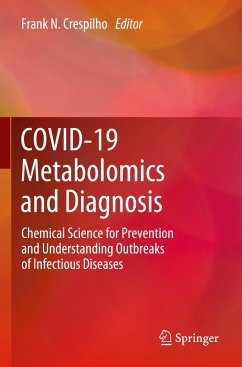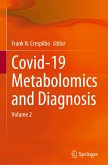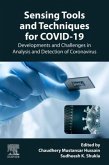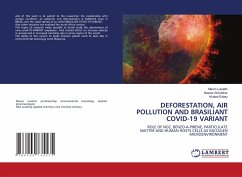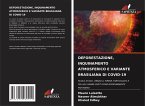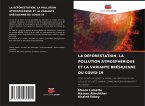COVID-19 Metabolomics and Diagnosis
Chemical Science for Prevention and Understanding Outbreaks of Infectious Diseases
Herausgegeben:Crespilho, Frank N.
COVID-19 Metabolomics and Diagnosis
Chemical Science for Prevention and Understanding Outbreaks of Infectious Diseases
Herausgegeben:Crespilho, Frank N.
- Broschiertes Buch
- Merkliste
- Auf die Merkliste
- Bewerten Bewerten
- Teilen
- Produkt teilen
- Produkterinnerung
- Produkterinnerung
This book focus on COVID-19 topics, with emphasis on metabolomics and diagnosis. The chapters cover the chemical science for prevention and understanding outbreaks of infectious diseases. This book compiles the most widespread methodologies of application of quality statistical tools added to the evaluation of diagnostic tests for detection of SARS-CoV-2, metabolic behavior of COVID infection severity, and trends in rapid test for COVID-19.
Andere Kunden interessierten sich auch für
![COVID-19 Metabolomics and Diagnosis COVID-19 Metabolomics and Diagnosis]() COVID-19 Metabolomics and Diagnosis110,99 €
COVID-19 Metabolomics and Diagnosis110,99 €![Covid-19 Metabolomics and Diagnosis Covid-19 Metabolomics and Diagnosis]() Covid-19 Metabolomics and Diagnosis124,99 €
Covid-19 Metabolomics and Diagnosis124,99 €![Sensing Tools and Techniques for COVID-19 Sensing Tools and Techniques for COVID-19]() Sensing Tools and Techniques for COVID-19128,99 €
Sensing Tools and Techniques for COVID-19128,99 €![DEFORESTATION, AIR POLLUTION AND BRASILIANT COVID-19 VARIANT DEFORESTATION, AIR POLLUTION AND BRASILIANT COVID-19 VARIANT]() Mauro LuisettoDEFORESTATION, AIR POLLUTION AND BRASILIANT COVID-19 VARIANT29,99 €
Mauro LuisettoDEFORESTATION, AIR POLLUTION AND BRASILIANT COVID-19 VARIANT29,99 €![DEFORESTAZIONE, INQUINAMENTO ATMOSFERICO E VARIANTE BRASILIANA DI COVID-19 DEFORESTAZIONE, INQUINAMENTO ATMOSFERICO E VARIANTE BRASILIANA DI COVID-19]() Mauro LuisettoDEFORESTAZIONE, INQUINAMENTO ATMOSFERICO E VARIANTE BRASILIANA DI COVID-1929,99 €
Mauro LuisettoDEFORESTAZIONE, INQUINAMENTO ATMOSFERICO E VARIANTE BRASILIANA DI COVID-1929,99 €![LA DÉFORESTATION, LA POLLUTION ATMOSPHÉRIQUE ET LA VARIANTE BRÉSILIENNE DU COVID-19 LA DÉFORESTATION, LA POLLUTION ATMOSPHÉRIQUE ET LA VARIANTE BRÉSILIENNE DU COVID-19]() Mauro LuisettoLA DÉFORESTATION, LA POLLUTION ATMOSPHÉRIQUE ET LA VARIANTE BRÉSILIENNE DU COVID-1929,99 €
Mauro LuisettoLA DÉFORESTATION, LA POLLUTION ATMOSPHÉRIQUE ET LA VARIANTE BRÉSILIENNE DU COVID-1929,99 €![DESMATAMENTO, POLUIÇÃO DO AR E VARIANTE COVID-19 BRASILIENSE DESMATAMENTO, POLUIÇÃO DO AR E VARIANTE COVID-19 BRASILIENSE]() Mauro LuisettoDESMATAMENTO, POLUIÇÃO DO AR E VARIANTE COVID-19 BRASILIENSE29,99 €
Mauro LuisettoDESMATAMENTO, POLUIÇÃO DO AR E VARIANTE COVID-19 BRASILIENSE29,99 €-
-
-
This book focus on COVID-19 topics, with emphasis on metabolomics and diagnosis. The chapters cover the chemical science for prevention and understanding outbreaks of infectious diseases. This book compiles the most widespread methodologies of application of quality statistical tools added to the evaluation of diagnostic tests for detection of SARS-CoV-2, metabolic behavior of COVID infection severity, and trends in rapid test for COVID-19.
Produktdetails
- Produktdetails
- Verlag: Springer / Springer International Publishing / Springer, Berlin
- Artikelnr. des Verlages: 978-3-031-15891-9
- 1st ed. 2023
- Seitenzahl: 200
- Erscheinungstermin: 22. Februar 2024
- Englisch
- Abmessung: 235mm x 155mm x 12mm
- Gewicht: 314g
- ISBN-13: 9783031158919
- ISBN-10: 3031158911
- Artikelnr.: 69853686
- Verlag: Springer / Springer International Publishing / Springer, Berlin
- Artikelnr. des Verlages: 978-3-031-15891-9
- 1st ed. 2023
- Seitenzahl: 200
- Erscheinungstermin: 22. Februar 2024
- Englisch
- Abmessung: 235mm x 155mm x 12mm
- Gewicht: 314g
- ISBN-13: 9783031158919
- ISBN-10: 3031158911
- Artikelnr.: 69853686
Frank N. Crespilho is Professor of Physical-Chemistry at Chemistry Institute of University of Sao Paulo, São Carlos, since 2012. He was Associate Professor of Chemistry at Federal University (UFABC), Brazil (2009-2012), Visiting Associate in Chemistry at California Institute of Technology, Caltech (EUA), and Visiting Professor at Max-Planck-Institute for Solid State Research, Stuttgart, Germany (2016). He was Visiting Professor at Harvard University (2018-2019), and since 2019, he is Fellow of the J. A. P. School of Engineering and Applied Sciences, Harvard University, at the laboratory of Prof. Michael Aziz. He is Coordinator of COVID-19 Network in metabolomics and diagnostics chemistry at the University of São Paulo. He was one of the inventors of the "Popular Fast Test of COVID-19," costing less than a dollar, for mass testing in developing countries. His research interests include fundamental and applied bioelectrochemistry with a distinctive focus on the chemistry of energy, life and health. His work combines physical-chemical methods and instrumentation development timely application to biological fuel cells and bioinspired batteries, biosensors technology, and electron transfer reactions in biological system. His recent work focuses on in situ and operando spectroscopic-electrochemistry elucidation of the electron transfer mechanism involving redox enzyme, proteins, DNA, and drug delivery in single cells. He has made contributions on the field of protein immobilization processes on solid surfaces, single-cell micro-FTIR analysis, bio-electrocatalysis, and coupling analytical tools to resolve electron transfer mechanism in proteins. He developed a technique named Electrochemical Coupled Vibrational Spectromicroscopy (EVSM), which consists in a multiplex infrared spectroscopy imaging system for monitoring spatially resolved redox chemistry in bioelectrodes, bioinorganic molecules, biological films, and single cells.
Chapter 1. Trends in Electroanalytical Assays for Covid 19 diagnosis.- Chapter 2. Microfluidic devices with electrochemical detection towards covid-19 detection.- Chapter 3. Carbon-based materials for electrochemical sensing of SARS-CoV-2.- Chapter 4. Electrochemical Immunosensor for diagnosis of COVID-19.- Chapter 5. Optical Fibers Sensors for Detection of SARS-CoV-2 Infection.- Chapter 6. Lateral flow assays for COVID-19.- Chapter 7. The use of NMR based metabolomics to discriminate patients with viral diseases.- Chapter 8. Application of quality statistical tools for the evaluation of diagnostic tests for SARS-CoV-2 detection
Chapter 1. Trends in Electroanalytical Assays for Covid 19 diagnosis.- Chapter 2. Microfluidic devices with electrochemical detection towards covid-19 detection.- Chapter 3. Carbon-based materials for electrochemical sensing of SARS-CoV-2.- Chapter 4. Electrochemical Immunosensor for diagnosis of COVID-19.- Chapter 5. Optical Fibers Sensors for Detection of SARS-CoV-2 Infection.- Chapter 6. Lateral flow assays for COVID-19.- Chapter 7. The use of NMR based metabolomics to discriminate patients with viral diseases.- Chapter 8. Application of quality statistical tools for the evaluation of diagnostic tests for SARS-CoV-2 detection

